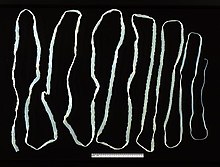| Taenia | |
|---|---|

| |
| Taenia saginata | |
| Scientific classification | |
| Domain: | Eukaryota |
| Kingdom: | Animalia |
| Phylum: | Platyhelminthes |
| Class: | Cestoda |
| Order: | Cyclophyllidea |
| Family: | Taeniidae |
| Genus: | Taenia Linnaeus, 1758 |
| Type species | |
| Taenia solium | |
Taenia is the type genus of the Taeniidae family of tapeworms (a type of helminth). It includes some important parasites of livestock. Members of the genus are responsible for taeniasis and cysticercosis in humans, which are types of helminthiasis belonging to the group of neglected tropical diseases. More than 100 species are recorded. They are morphologically characterized by a ribbon-like body composed of a series of segments called proglottids; hence the name Taenia (Greek ταίνια, tainia meaning ribbon, bandage, or stripe). The anterior end of the body is the scolex. Some members of the genus Taenia have an armed scolex (hooks and/or spines located in the "head" region); of the two major human parasites, Taenia saginata has an unarmed scolex, while Taenia solium has an armed scolex.[1]
The proglottids have a central ovary, with a vitellarium (yolk gland) posterior to it. As in all cyclophyllid cestodes, a genital pore occurs on the side of the proglottid. Eggs are released when the proglottid deteriorates, so a uterine pore is unnecessary.
- ^ Roberts, L.S. and Janovy, John Jr. Foundations of Parasitology 7th Edition. McGraw-Hill. 2005.